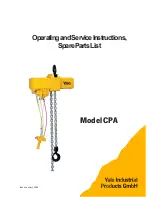
4
Temperature range:
The hoists can be operated in ambient temperatures between
-10
O
C and +50
O
C.
Consult the manufacturer in case of extreme working conditions.
Note: At ambient temperatures below 0
O
C check the brake is not
frozen.
Regulations
The accident prevention act and/or safety regulations of the re-
spective country for using manual hoists must be strictly adhered
to. In Germany these are VGB8, VBG9, VBG9a, ZHI/25, ZHI/27.
Maintenance / Repair:
In order to ensure correct operation not only the operating instruc-
tions, but also the conditions for inspection and maintenance must
be complied with. If defects are found stop using the hoist imme-
diately.
Attention
: Before starting work on pneumatic components switch
OFF the main air supply and secure it against unintentionally be-
ing switched back on.
2.2 INCORRECT OPERATION
• Do not exceed the rated capacity of the hoist.
• Do not use the hoist for the transportation of people (fig. 3)
• Welding on hook and load chain is strictly forbidden. The load
chain must never be used as a ground connection during welding
(fig. 4).
Avoid side pull, i. e. side load on either housing or bottom block
(fig. 5).
• Lift/ pull/ tension only when load chain forms a straight line be-
tween both hooks.
• The load chain must not be used for lashing purposes (sling
chain) (fig. 6).
• Do not knot or shorten the load chain by using bolts / screws /
screwdrivers or other devices (fig. 7). Do not repair load chains
installed in the hoist.
• Do not remove the safety latch from the suspension or load
hooks (fig. 8).
• Do not use the chain stop as an operational limit device
(see fig. 1 - chain stop)
• Do not throw the hoist down. Always place it properly on the
ground.
2.3 COMMISSIONING
Inspection before initial operation
Each hoist must be inspected prior to initial operation by a
competent person and any faults rectified. The inspection is
visual and functional and shall establish that the hoist is safe
and has not been damaged by incorrect transport or storage.
Inspections should be made by a representative of the manu-
facturer or the supplier although the company can assign its
own suitably trained personnel.
Inspections are instigated by the user.
Inspection before starting work:
Before starting work inspect the hoist, chain(s) and all load
bearing constructions every time for visual defects. Further-
more test the brake and that the load and hoist are correctly
attached by carrying out a short work cycle of lifting/pulling or
tensioning and releasing. The selection and calculation of a
suitable suspension point for the hoist is the responsibility of
the user.
Inspection of load chain:
Inspect the load chain for sufficient lubrication and visually
check for external defects, deformations, superficial cracks,
wear or signs of corrosion.
Inspection of chain stop:
The chain stop must be connected to the free (idle) chain
strand ( see fig. 1 - chain stop ).
Inspection of chain reeving:
All units equipped with two or more chain strands should be
inspected prior to initial operation for twisted or kinked chains.
The chains of two strand hoists may be twisted if the bottom
block was rolled over (see fig. 9).
Inspection of suspension and load hooks
Inspect suspension and load hooks for deformations,
damage, cracks, wear or signs of corrosion.
Fig. 4
Fig. 3
Fig. 5
Fig. 6
Fig. 8
Fig. 7



















